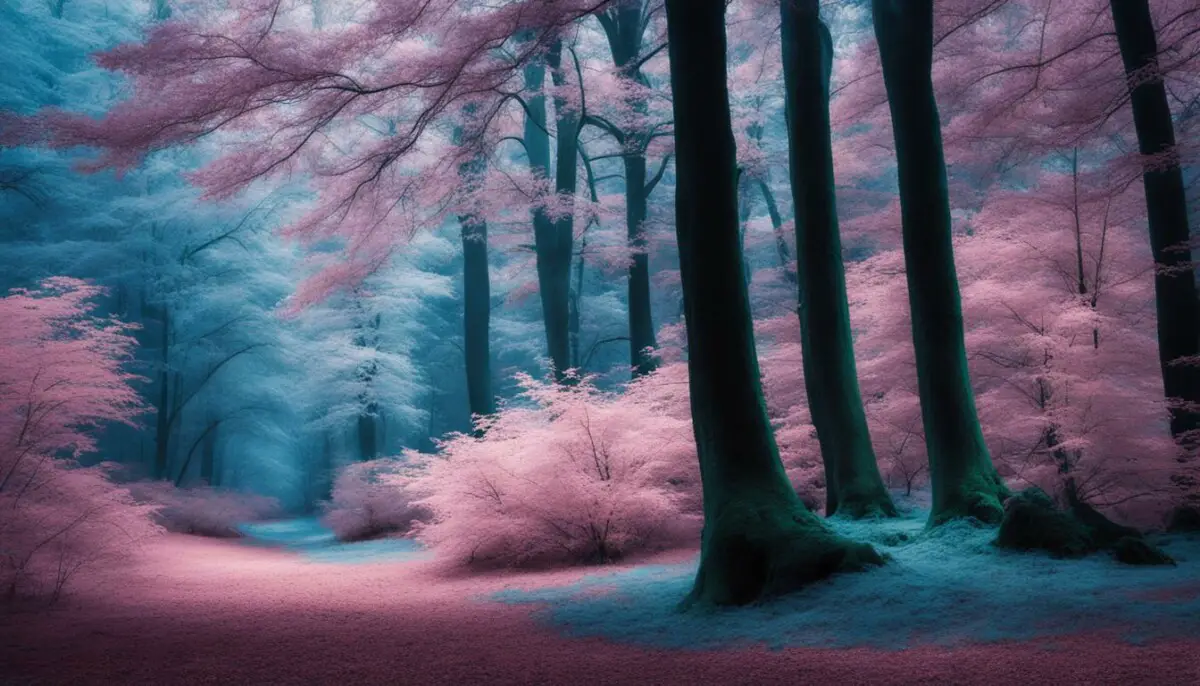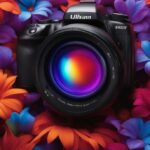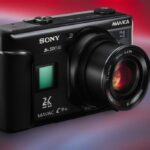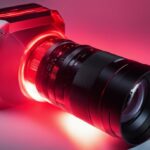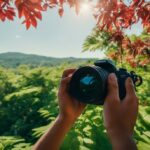Last Updated on 4 months by Francis
Infrared photography has become more accessible with the advancement of digital cameras. While shooting infrared photos was complicated and expensive with film photography, digital cameras have made the technique almost foolproof and inexpensive. All you need is a tripod, a special infrared filter, and a digital camera that is sensitive to infrared light. Shooting infrared with a digital camera allows you to capture the unseen beauty of the infrared spectrum.
Contents
Key Takeaways:
- Digital cameras have made infrared photography more accessible and affordable.
- To capture infrared photos, you will need a tripod, an infrared filter, and a camera sensitive to infrared light.
- Infrared light falls outside the visible light spectrum but can be captured by certain digital cameras.
- Testing your camera for infrared sensitivity is important before investing in additional equipment.
- Adjusting camera settings and post-processing are crucial steps in achieving desired infrared effects.
Understanding Infrared Light
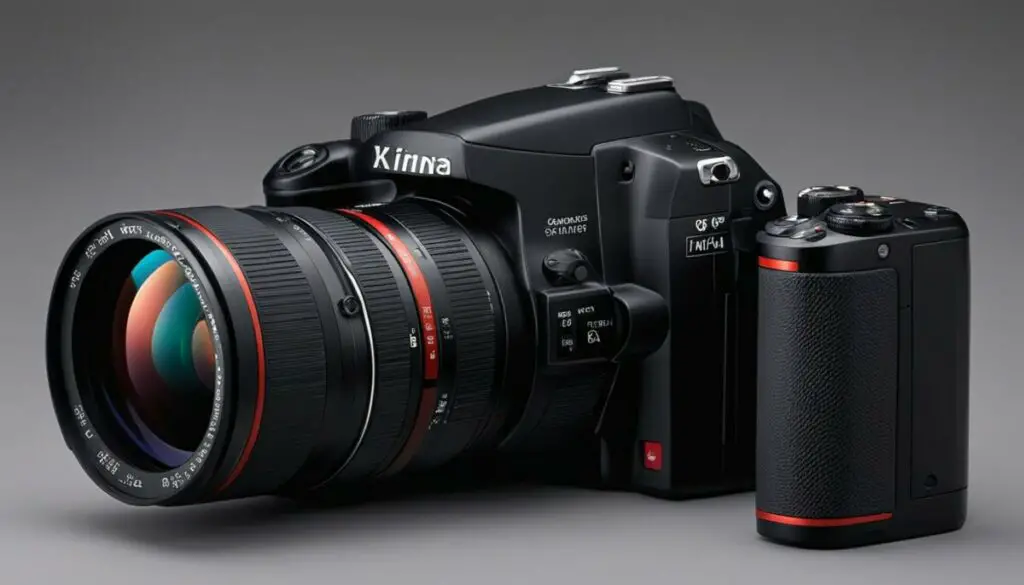
Infrared light is a form of electromagnetic radiation that exists outside of the visible light spectrum. While our human eyes cannot perceive infrared light, certain digital cameras have the capability to capture it. Infrared light has a wavelength that differs from visible light, and it interacts with objects in unique ways, resulting in captivating and surreal images.
When it comes to capturing infrared images with a digital camera, it is essential to have a camera with infrared capability. These specialized cameras are equipped with sensors that can detect and record infrared light. To ensure that only infrared light reaches the camera sensor, special filters are used to block out visible light. These filters allow for the exclusive capture of the infrared spectrum.
“Infrared light unveils a hidden world of mesmerizing beauty that is invisible to the naked eye.”
| Visible Light | Infrared Light |
|---|---|
| Perceived by the human eye | Cannot be seen by the human eye |
| Interacts with objects based on their color and reflectivity | Interacts differently with objects, revealing unique textures and details |
| Typically captured in color | Captured in monochrome or false color |
The ability to capture infrared light with a digital camera opens up a whole new realm of creative possibilities for photographers. It allows them to explore and showcase the hidden elements and ethereal qualities of the infrared spectrum.
A digital camera with infrared capability can capture the unseen beauty of the infrared spectrum.
Testing Your Camera for Infrared Sensitivity

Before you start shooting infrared photos with your digital camera, it’s important to test if your camera is sensitive to infrared light. Not all digital cameras are capable of capturing infrared images, so it’s essential to check your camera’s sensitivity before investing in any additional equipment.
One simple test involves using a TV remote control and observing if the infrared light emitted by the remote is visible through your camera’s viewfinder or LCD screen. If your camera can detect infrared light, you can proceed with shooting infrared photos.
To perform the test:
- Set up your camera on a tripod for stability.
- Point the TV remote control towards the camera lens.
- Press any button on the remote while looking through the viewfinder or at the LCD screen.
- If you see a bright white or purple light flashing, your camera is sensitive to infrared light.
If your camera doesn’t detect the infrared light emitted by the remote, it may not be capable of capturing infrared images. In this case, you can consider purchasing a camera specifically designed for infrared photography or modify your current camera for infrared sensitivity.
By testing your camera’s infrared sensitivity, you can ensure that you’re equipped to take stunning infrared pictures with your digital camera.
Equipment Needed for Infrared Photography
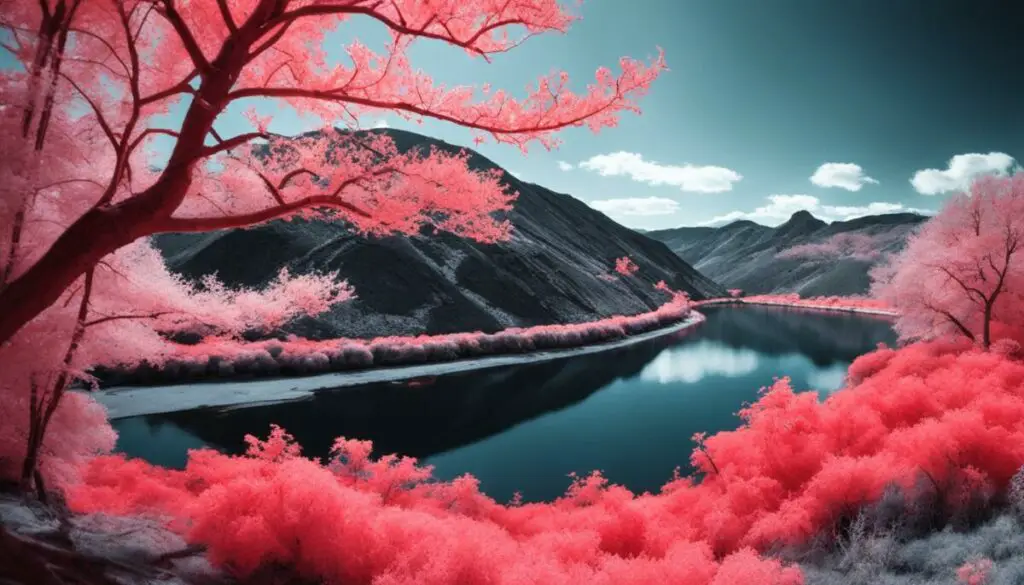
To capture stunning infrared images with your digital camera, you will need some essential equipment. Here are the key items you should consider:
Tripod
A tripod is crucial for achieving sharp and stable infrared photos, especially during long exposures. It ensures that your camera remains steady, minimizing any potential blurriness in your images. Invest in a sturdy tripod to get the best results.
Infrared Filter
An infrared filter is a must-have accessory for shooting infrared photos with a digital camera. A high-quality filter blocks out visible light and only allows infrared light to pass through. There are different types of infrared filters available, including screw-on filters and slide-in filters that work with filter holder systems. Choose a filter that suits your camera and shooting preferences.
Note: The effectiveness of an infrared filter may vary depending on your camera’s infrared sensitivity. Make sure to test your camera’s capability before purchasing an infrared filter.
Additional Accessories
While a tripod and an infrared filter are the primary equipment needed for infrared photography, depending on your specific requirements and shooting style, consider these additional accessories:
- Lens Hood: Helps minimize lens flare and stray light that can affect image quality.
- Remote Shutter Release: Allows you to trigger the camera without touching it, reducing the risk of camera movement.
- Spare Batteries and Memory Cards: Infrared photography often involves longer exposures, thus consuming more battery power. Make sure to carry extra batteries and memory cards for uninterrupted shooting.
- Camera Bag: Protects your camera and accessories while providing easy transportability.
Having these essential equipment will equip you well for shooting incredible infrared photos with your digital camera. Now that you have everything you need, let’s move on to the next section to explore the optimal camera settings for infrared photography.
Camera Settings for Infrared Photography
When capturing stunning infrared photos using your digital camera, it’s important to adjust specific camera settings to achieve optimal results. By fine-tuning these settings, you can bring out the mesmerizing beauty of the infrared spectrum and create captivating images.
To begin, consider the following camera settings:
- ISO: Set your ISO between 200 and 400 to maintain low noise levels in your infrared images. This ensures that the details remain sharp and the colors are rich and vibrant.
- Long Exposure Noise Reduction: Enable this feature to minimize noise in long exposure shots. It eliminates any unwanted artifacts that may appear during extended exposure times.
- RAW Mode: Shoot in RAW mode to have more flexibility during post-processing. RAW files preserve the most amount of data, allowing for greater adjustments and enhancements without sacrificing image quality.
- Aperture Priority Mode: Use aperture priority mode and set your aperture to around f/8 for maximum sharpness throughout the frame. This ensures that your infrared images have exceptional detail and clarity.
- Auto Bracketing: If your camera supports auto bracketing, consider utilizing this feature to capture a series of exposures. Auto bracketing allows you to blend multiple images with different exposures, resulting in a wider dynamic range and greater tonal representation.
- White Balance: Adjust the white balance to the sunny or daylight preset for accurate color reproduction. This maintains the authenticity of your infrared images and enhances the overall visual appeal.
By applying these camera settings, you can unlock the true potential of your digital camera and create breathtaking infrared photographs that showcase the hidden beauty of the world around us.
Composition Tips for Infrared Photography

Composition plays a crucial role in infrared photography, just like in any other genre of photography. When capturing infrared landscapes, it’s important to consider the placement and arrangement of various elements within the frame. Here are some composition tips to help you create visually captivating infrared photographs:
- Contrasting Elements: Incorporate contrasting elements, such as light and dark objects, to add visual interest and depth to your infrared shots. This can create a beautiful play of tones and textures in your compositions.
- Smooth and Textured Surfaces: Experiment with including both smooth and textured surfaces in your images. These contrasting surfaces can contribute to the overall visual impact of your photograph, adding visual diversity and intrigue.
Combining elements from different columns, such as light/dark and smooth/textured, can result in visually striking and dynamic compositions in infrared photography. By carefully arranging these elements, you can create images that evoke a sense of mystery and surreal beauty.
It’s important to note that infrared light interacts differently with various objects. Foliage and clouds, for example, tend to reflect more infrared light, appearing brighter in infrared images. On the other hand, objects like stones and water absorb infrared light, appearing darker. Keep these characteristics in mind when composing your shots to achieve the desired visual impact.
Experimentation is key when it comes to composition in infrared photography. Try different angles, perspectives, and arrangements of elements to create visually compelling and unique infrared landscapes. Allow your creativity to flourish and explore the limitless possibilities of infrared photography.
Recommended Shooting Conditions for Infrared Photography
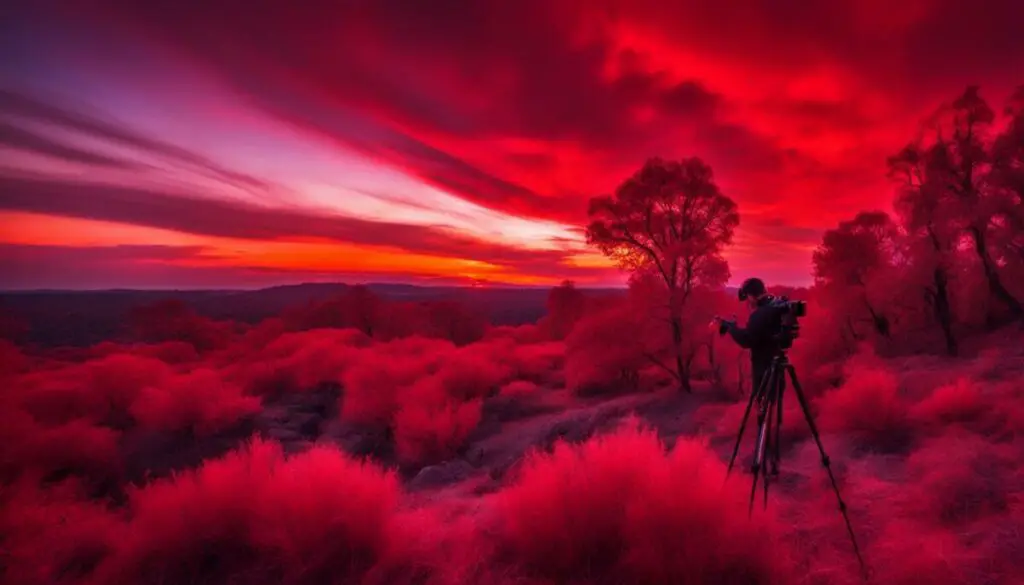
Infrared photography offers a unique and captivating way to explore the world around us. To achieve the best results, it’s important to consider the shooting conditions when planning your infrared photo sessions.
1. Bright, Sunny Conditions:
For optimal infrared photography, it’s best to shoot in bright, sunny conditions. This ensures that there is plenty of infrared light available, allowing you to capture the unseen beauty of the infrared spectrum. Overcast days may result in less infrared light, leading to less vibrant and impactful infrared images.
2. Abundant Deciduous Foliage:
The presence of abundant deciduous foliage can greatly enhance your infrared images. During the summer season, when trees are in full bloom, the foliage reflects a significant amount of infrared light, resulting in brighter and more visually striking images. So, consider shooting your infrared photos during the summer months to make the most of this natural phenomenon.
3. Avoid Snowy Winter Days:
While winter landscapes can be visually appealing for traditional photography, they may not be the best choice for infrared photography. Snow-covered scenes tend to have fewer living things that reflect the most infrared light, resulting in darker and less vibrant images. Instead, focus on shooting infrared photos during seasons with lush foliage for the best results.
When choosing shooting locations, look for interesting elements such as graveyards, parks, or old buildings. These locations often provide unique tonality and texture, adding depth and character to your infrared images.
| Recommended Shooting Conditions: | Not Recommended Shooting Conditions: |
|---|---|
| Bright, sunny days | Overcast days with minimal sunlight |
| Summer season with abundant foliage | Snowy winter days with limited foliage |
| Locations with interesting elements | Featureless or uninteresting locations |
By considering these recommended shooting conditions, you can maximize the potential of your infrared photography and create stunning, otherworldly images that will captivate viewers.
Continue reading to learn more about the post-processing techniques that will further enhance your infrared images!
Post-Processing Infrared Images
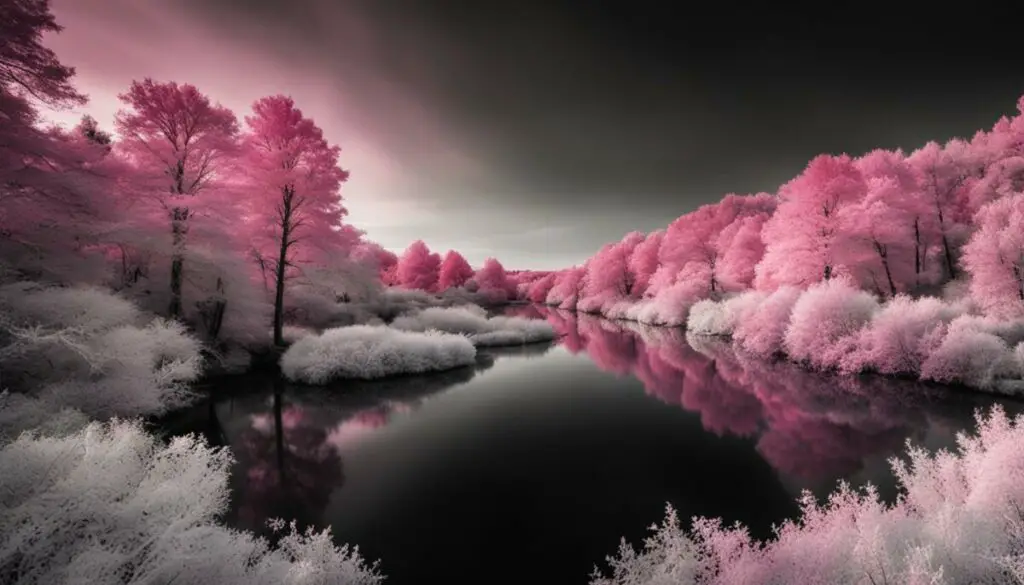
After capturing mesmerizing infrared photos, the journey continues with the crucial step of post-processing. This creative phase allows you to enhance and emphasize the unique qualities of the infrared light, transforming your images into captivating works of art.
Infrared images often require careful adjustments to various elements to achieve the desired visual impact. Here are some essential post-processing techniques to consider:
1. White Balance Adjustment
Adjusting the white balance is crucial to ensure accurate color representation in your infrared images. As infrared light interacts differently with objects, the automatic white balance settings of your camera might not accurately translate the tones. Experiment with different white balance settings, such as custom or manual adjustments or applying preset options specific to infrared photography, like the “Cloudy” or “Shade” presets, to achieve the desired color balance.
2. Channel Swapping
Channel swapping is a popular technique used in post-processing infrared images. It involves swapping the color channels, such as red and blue, to create visually striking effects. Channel swapping can provide a fresh perspective on your infrared photographs by introducing unexpected color combinations or enhancing specific elements.
3. Tonal Adjustments
Tonal adjustments are vital in bringing out the desired contrast and tonal range in your infrared images. Experiment with techniques like curves adjustments or selective contrast enhancements to emphasize the textures, shadows, and highlights, thus adding depth and dimension to your photographs.
| Post-Processing Techniques for Infrared Images: | Benefits: |
|---|---|
| White balance adjustment | Ensures accurate color representation |
| Channel swapping | Introduces visually striking effects |
| Tonal adjustments | Enhances contrast and tonal range |
4. Experimentation with Editing Techniques
Software tools like Adobe Photoshop Lightroom offer a wide range of editing options specifically tailored for infrared images. Don’t be afraid to experiment with different editing techniques to unlock the full creative potential of your infrared photographs. Whether it’s applying artistic filters, creating dramatic black and white conversions, or exploring surreal effects, post-processing allows you to fully express your vision and create captivating infrared masterpieces.
Post-processing can elevate your infrared images, amplifying their dreamlike and otherworldly qualities. It’s a creative process that truly enhances the artistic impact of your photographs while allowing you to develop a distinct style and voice in the world of infrared photography.
Exploring the World of Infrared Photography
Infrared photography opens up a world of creative possibilities beyond landscapes. While capturing stunning infrared landscapes is a popular choice, there are many other subjects and techniques to explore in this unique genre of photography.
One intriguing application of infrared photography is in portrait photography. When using infrared light, portraits can take on an ethereal and ghostly quality, with the skin appearing smooth and luminous. This technique can create truly memorable and captivating images that stand out from traditional portrait photography.
Night sky photography is another exciting avenue to explore with infrared photography. By incorporating infrared light into your night sky shots, you can add a new dimension and create photographs with an otherworldly feel. Imagine capturing the stars and constellations in a hauntingly beautiful way, enhanced by the invisible infrared light.
Experimentation is key to discovering the diverse artistic opportunities offered by infrared photography. Explore different subjects, such as architecture, still life, or street photography, and see how infrared light transforms these scenes. With practice, you can develop your own unique style and push the boundaries of what’s possible with infrared photography.
Whether you’re drawn to the captivating landscapes, the hauntingly beautiful portraits, or the surreal night sky shots, infrared photography offers endless creative possibilities. Embrace this unique technique, explore new horizons, and capture images that leave a lasting impression.
Conclusion
Infrared photography offers a gateway to capturing the unseen beauty of the world and creating surreal and captivating images. With the right equipment and camera settings, anyone can delve into the fascinating world of infrared photography and unlock the hidden potential of their digital camera.
One of the benefits of shooting infrared photos is the ability to capture stunning landscapes in a unique way. By harnessing the power of infrared light, photographers can create otherworldly scenes where foliage appears bright and ethereal, while rocks and water take on a darker, more mysterious tone. Infrared photography opens up a whole new range of artistic possibilities for landscape enthusiasts.
But the creative opportunities go beyond just landscapes. Infrared photography can also be used in portrait photography, producing ethereal and ghostly effects. Skin tones become smooth and luminous, lending a dreamlike quality to the images. Additionally, infrared photography can add a new dimension to night sky photography, incorporating the enchanting glow of infrared light into the celestial scenery.
Start exploring the captivating world of infrared photography and discover the hidden beauty of the infrared spectrum. With its ability to capture the unseen, the surreal, and the captivating, infrared photography offers a rewarding experience for photographers looking to push the boundaries of their creativity.
FAQ
Can a digital camera capture infrared pictures?
Yes, with the right equipment and settings, a digital camera can capture stunning infrared images that reveal the unseen beauty of the infrared spectrum.
How does a digital camera capture infrared light?
Digital cameras with infrared capability use special filters that block visible light and allow only infrared light to reach the camera sensor, resulting in unique and surreal infrared images.
How can I test if my digital camera is sensitive to infrared light?
You can test your camera’s sensitivity to infrared light by using a TV remote control and observing if the infrared light emitted by the remote is visible through your camera’s viewfinder or LCD screen.
What equipment do I need for infrared photography with a digital camera?
To capture infrared images with your digital camera, you will need a tripod to stabilize your camera, and an infrared filter that blocks visible light and allows only infrared light to pass through.
What camera settings should I use for infrared photography?
For optimal results, set your ISO between 200 and 400, enable long exposure noise reduction, shoot in RAW mode, use aperture priority mode with an aperture around f/8, and adjust the white balance to the sunny or daylight preset.
Any composition tips for infrared photography?
When composing infrared shots, consider incorporating contrasting elements such as light and dark objects, as well as smooth and textured surfaces to create visually striking and dynamic compositions.
What are the recommended shooting conditions for infrared photography?
Infrared photography is best done in bright, sunny conditions with plenty of infrared light available. Locations with abundant deciduous foliage can enhance the tonality and texture of infrared images.
How should I post-process my infrared images?
Infrared images often require adjustments to white balance, channel swapping, and tonal adjustments to achieve the desired look. Software tools like Adobe Photoshop Lightroom can be used to edit and manipulate infrared images.
What are the creative possibilities with infrared photography?
Infrared photography offers diverse artistic opportunities beyond landscapes, including ethereal portrait effects and unique night sky photography with infrared light. Experiment with different subjects and techniques to explore the creative possibilities.
Why should I try infrared photography with my digital camera?
Infrared photography allows you to capture unseen beauty, create surreal and captivating images, and develop your own unique style. It is an exciting and rewarding genre of photography that offers a fresh perspective.
Source Links
- https://digital-photography-school.com/how-to-do-surreal-digital-infrared-photography-without-expensive-gear-or-camera-conversions/
- https://iceland-photo-tours.com/articles/photography-tutorials/beginner-s-guide-to-infrared-photography
- https://www.adobe.com/creativecloud/photography/discover/infrared-photography.html

